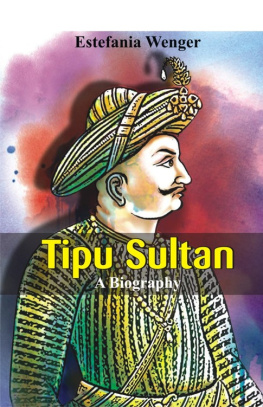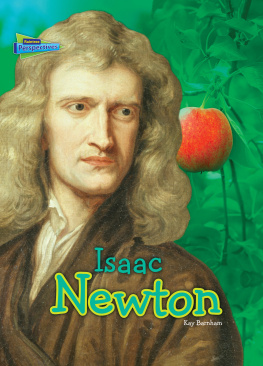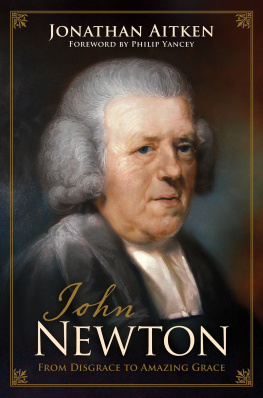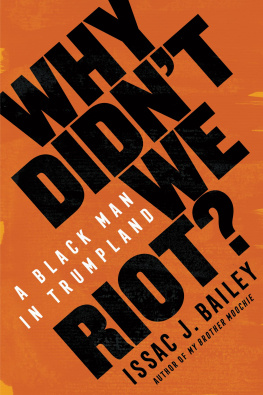Issac Newton
Issac Newton
A Biography
Estefania Wenger
Alpha Editions
Copyright 2017
ISBN : 9789386367297
Design and Setting By
Alpha Editions
email - alphaedis@gmail.com
All rights reserved. No part of this publication may be reproduced, distributed, or transmitted in any form or by means, including photocopying, recording, or other electronic or mechanical methods, without the prior written permission of the publisher.
The views and characters expressed in the book are of the author and his/her imagination and do not represent the views of the Publisher.
Contents
Introduction
Early Life
Later Life
Religious views of Isaac Newton
Isaac Newton's occult studies
Isaac Newton in popular culture
Apple incident
About the Author
Introduction
Sir Isaac Newton FRS was an English physicist and mathematician (described in his own day as a "natural philosopher") who is widely recognised as one of the most influential scientists of all time and a key figure in the scientific revolution. His book Philosophi Naturalis Principia Mathematica ("Mathematical Principles of Natural Philosophy"), first published in 1687, laid the foundations for classical mechanics. Newton made seminal contributions to optics, and he shares credit with Gottfried Wilhelm Leibniz for the development of calculus.
Newton's Principia formulated the laws of motion and universal gravitation, which dominated scientists' view of the physical universe for the next three centuries. By deriving Kepler's laws of planetary motion from his mathematical description of gravity, and then using the same principles to account for the trajectories of comets, the tides, the precession of the equinoxes, and other phenomena, Newton removed the last doubts about the validity of the heliocentric model of the Solar System. This work also demonstrated that the motion of objects on Earth and of celestial bodies could be described by the same principles. His prediction that Earth should be shaped as an oblate spheroid was later vindicated by the measurements of Maupertuis, La Condamine, and others, which helped convince most Continental European scientists of the superiority of Newtonian mechanics over the earlier system of Descartes.
Newton built the first practical reflecting telescope and developed a theory of colour based on the observation that a prism decomposes white light into the many colours of the visible spectrum. He formulated an empirical law of cooling, studied the speed of sound, and introduced the notion of a Newtonian fluid. In addition to his work on calculus, as a mathematician Newton contributed to the study of power series, generalised the binomial theorem to non-integer exponents, developed a method for approximating the roots of a function, and classified most of the cubic plane curves.
Newton was a fellow of Trinity College and the second Lucasian Professor of Mathemati cs at the University of Cambridge. He was a devout but unorthodox Christian, and , unusually for a member of the Cambridge faculty of the day, he refused to take holy orders in the Chu rch of England, perhaps because he privately rejected the doctrine of the Trinity. Beyond his work on th e mathematical sciences, Newton dedicated much of his time to the study of biblical chronology and a lchemy, but most of his work in those areas remained unpublished until long after his death. In his later life, Newton became president of the Royal Society. Newton served the British government as Warden and Master of the Royal Mint.
Early Life
Isaac Newton was born on Christmas Day, 25 December 1642 Old Style (which is 4 January 1643 on the Gregorian calendar, which is now used) at Woolsthorpe Manor in Woolsthorpe-by-Colsterworth, a hamlet in the county of Lincolnshire. At the time of Newton's birth, England had not adopted the Gregorian calendar and therefore his date of birth was recorded as Christmas Day, according to the Julian calendar.
Newton was born three months after the death of his father, a prosperous farmer also named Isaac Newton. Isaac Newton, Sr. was described as a "wild and extravagant man." Born prematurely, young Isaac was a small child; his mother Hannah Ayscough reportedly said that he could have fitted inside a quart mug. When Newton was three, his mother remarried and went to live with her new husband, the Reverend Barnabus Smith, leaving her son in the care of his maternal grandmother, Margery Ayscough. The young Isaac disliked his stepfather and held some enmity towards his mother for marrying him, as revealed by this entry in a list of sins committed up to the age of 19: "Threatening my father and mother to burn them and the house over them." Later on his mother returned after her husband died.
From the ages of 12 through 17, he was educated at The King's School, Grantham (where his signature can still be seen upon a library window sill). He was removed from school, and by October 1659, he was to be found at Woolsthorpe-by-Colsterworth, where his mother, widowed by now for a second time, attempted to make a farmer of him. He hated farming. Henry Stokes, master at the King's School, persuaded his mother to send him back to school so that he might complete his education. This he did at the age of eighteen, achieving an admirable final report.
In June 1661, he was admitted to Trinity College, Cambridge as a sizara sort of work-study role. At that time, the college's teachings were based on those of Aristotle, whom Newton supplemented with modern philosophers such as Descartes and astronomers such as Copernicus, Galileo, and Kepler. In 1665, he discovered the generalised binomial theorem and began to develop a mathematical theory that later became infinitesimal calculus. Soon after Newton had obtained his degree in August 1665, the University closed down as a precaution against the Great Plague. Although he had been undistinguished as a Cambridge student, Newton's private studies at his home in Woolsthorpe over the subsequent two years saw the development of his theories on calculus, optics and the law of gravitation. In 1667 he returned to Cambridge as a fellow of Trinity.
Newton had stated that when he had purchased a book on astrology at Stourbridge fair, near Cambridge, he was unable, on account of his ignorance of trigonometry, to understand a figure of the heavens which was drawn in the book. He therefore bought an English edition of Euclid's Elements which included an index of propositions, and, having turned to two or three which he thought might be helpful, found them so obvious that he dismissed it "as a trifling book", and applied himself to the study of Ren Descartes' Geometry. It is reported that in his examination for a scholarship at Trinity, to which he was elected on 28 April 1664, he was examined in Euclid by Dr. Isaac Barrow, who was disappointed in Newton's lack of knowledge on the subject. Newton was convinced to read the Elements again with care, and formed a more favourable estimate of Euclid's merit.
The study of Descartes's Geometry seems to have inspired Newton with a love of the subject, and introduced him to higher mathematics. In a small commonplace book, dated January 1664, there are several articles on angular sections, and the squaring of curves and "crooked lines that may be squared", several calculations about musical notes, geometrical propositions from Franois Vite and Frans van Schooten, annotations out of John Wallis's Arithmetic of Infinities, together with observations on refraction, on the grinding of "spherical optic glasses", on the errors of lenses and the method of rectifying them, and on the extraction of all kinds of roots, particularly those "in affected powers." In this same book the following entry made by Newton himself, many years afterwards, gives a further account of the nature of his work during the period when he was an undergraduate:








